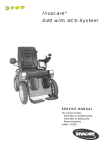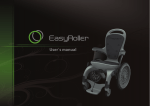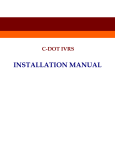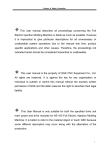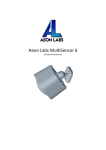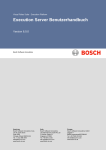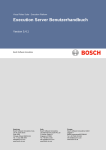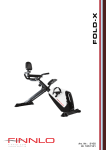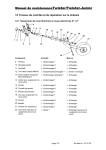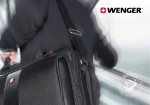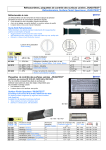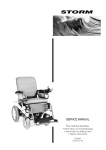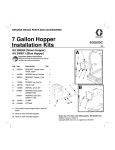Download Invacare® G40 with ACS
Transcript
Invacare ® G40 with ACS-System SERVICE-MANUAL The manual contains: Information on troubleshooting Information on testing parts Repair instructions Edition: 12.2001 General information This service manual contains all information necessary for maintenance and servicing of the “G40” wheelchair. • Maintenance and servicing work is to be carried out in accordance with this service manual. • Comply with all safety instructions • Information on operation, general maintenance and servicing can be found in the operating manual of “G40”. • Refer to the replacement parts catalog for information on ordering replacement parts. • Maintenance and repair work on the “G40” may onla be performed by qualified personnel. -Maintenance technicians should at least be trained in a relevant field, e.g. as a two-wheeled vehicle or orthopaedics technician, or have an equivalent amount of professional experience. -Personnel should also be familiar with electrical measurement equipment (multimeters). • Should you encounter difficulties or have any questions, please contact INVACARE-SERVICE: Switchboard: Tel. +049 (0)5731-754-0 Fax. +049 (0)5731-754-111 Service: Tel. +049 (0)5731-7545-(70-80) Fax. +049 (0)5731-7542-(08-16) Adress: PO Box: Invacare Deutschland GmbH Dehmer Str. 66 D-32549 Bad Oeynhausen Invacare Deutschland GmbH Postfach 60 01 06 D-32 527 Bad Oeynhausen • INVACARE can not be held liable for changes to the “G40” resulting from maintenance and servicing work carried out incorrectly or not according to the relevant instructions. Information concerning transportation • If the wheelchair has to be sent away to the manufacturer for more serious repairs, always use the original packaging for transportation. • Please include a detailed account of the fault. • We reserve the right to make changes in the interests of technical progress. You will notice the following symbols in this repair manual: NOTE: This symbol indicates general information concerning special features and helpful advice for installation. ACAUTION: Please pay special attention to this symbol. It indicates >Safety instructions<. 2 Contents 1.0 Safety and installation instructions . . . . . .4 10.0 Checks and repair work at 2.0 List of tools . . . . . . . . . . . . . . . . . . . . . . . .5 3.0 Inspection plan . . . . . . . . . . . . . . . . . . . . .6 4.0 4.1 4.2 Operation troubles . . . . . . . . . . . . . . . . . . .8 General instructions . . . . . . . . . . . . . . . . . .8 Troubleshooting . . . . . . . . . . . . . . . . . . . . .8 power supply 10.1 Batteries, battery box and check of . . . . . . battery voltage . . . . . . . . . . . . . . . . . . . . .29 10.2 Battery charging . . . . . . . . . . . . . . . . . . .30 10.3 Battery charger unit . . . . . . . . . . . . . . . . .31 5.0 5.1 Error messages at remote . . . . . . . . . . . . .10 Error codes of remote . . . . . . . . . . . . . . .10 6.0 Arrangement of assembly groups, components and operation elements . . . . . . . . . . . . . .12 7.0 Checks and repair work at seatsystem 7.1 7.2 7.3 14 Armrests and sides . . . . . . . . . . . . . . . . .14 Legrests . . . . . . . . . . . . . . . . . . . . . . . . .15 Backrest with frame, upholstery and hand grip . . . . . . . . . . . . . . . . . . . . . . . . . . . . .16 7.4 7.5 Backrest adjusting . . . . . . . . . . . . . . . . . .18 Seatframe, seat shell and padding . . . . .19 8.0 8.1 8.2 8.3 8.4 8.5 Checks and repair work at chassis . . . . . .20 Chassis covering, grips and cover coating20 Wheels and tyres . . . . . . . . . . . . . . . . . . .21 Back-wheel suspension . . . . . . . . . . . . . .22 Front.wheel suspension . . . . . . . . . . . . . .23 Handbrake . . . . . . . . . . . . . . . . . . . . . . . .24 9.0 Checks and repair work at motor, gears, servo and steering . . . . . . . . . . . . . . . . . .26 Driving motor and gears . . . . . . . . . . . . .26 Power-assisted steering unit . . . . . . . . . .28 9.1 9.2 11.0 Checks and repair work at lighting system . . . . . . . . . . . . . . . . . . . . .32 11.1 Front lighting system . . . . . . . . . . . . . . .32 11.2 Back lighting system . . . . . . . . . . . . . . . .33 12.0 Checks and repair work at electronics . . . . . . . . . . . . . . . . . . . . . . . .34 12.1 Main module . . . . . . . . . . . . . . . . . . . . . .34 12.2 Remote . . . . . . . . . . . . . . . . . . . . . . . . . .35 12.3 Light servo module . . . . . . . . . . . . . . . . .36 12.4 Speedometer . . . . . . . . . . . . . . . . . . . . .37 13.0 Continuity check of cables . . . . . . . . . . . .38 14.0 Programming of wheelchair . . . . . . . . . . .39 15.0 Storing of wheelchair . . . . . . . . . . . . . . . .39 3 1.0 Safety and installation instructions The safety instructions are provided in the interests of working safety and must under all circumstances be complied with. Prior to all inspection and repair work: • Read this service manual and the appertaining user manual. • Ensure that minimum qualifications for performing relevant work are fulfilled (see chapter entitled “General information”). Caution: • Note that some components are heavy. You should take this into account above all when removing the batteries. • The power supply for the wheelchair must be switched off before any conductive parts are removed. Remove the batteries. • When performing tests on conductive parts, ensure that the contacts are not short-circuited. > Danger of fire and injury from burns < • Only use tools which are in perfect working order and are not damaged. During work and assembly: • Mark the current settings of the wheelchair (seat, armrests, back etc.) and the combination of cable connections before carrying out disassembly work. This will make assembly an easier task afterwards. ACHTUNG: • Support the raised wheelchair with suitable supports before you begin assembly. Use the bottom tube . frames of the chassis. Also see the illustration G40, bottom view, chapter 6.0. • You should under no circumstances use “normal” nuts instead of self-locking nuts. • Always use correctly-sized washers or separators. Note: • All plug connectors are fitted with mechanical clamps which prevent slipping when the wheelchair is in operation. • These clamps must be pressed in to release the connectors. • When carrying out assembly work, ensure that the clamps are fitted properly. • For checks and repair works you can fold up the seat system and arrest. This position is called service position. Prior to initial use / after repair work: Caution: • Check firm mounting of all fastening screws. • Check that all parts are properly locked in place. • Check regulation tyre pressure (2.5 bar) before starting the machine. • Always perform a test-drive after repair work. 4 2.0 List of tools A standard toolkit comprising the following minimum inventory is required: Combination ring and open-end spanner SW 6, 7, 8, 10, 11, 12, 13, 17, 19 Allan key 2,5 mm, 3mm, 4mm, 5 mm, 6 mm, 8mm, 10mm Torque wrench (commercially available) Socket spanner set Screwdrivers for slotted screws various Crosstip screwdriver No.1, No.2 Side-cutting pliers Flat pliers Round pliers Cable lug pliers Wooden or plastic hammer Tyre repair set (commercially available) Air pressure gauge Valve extraction tools Special tool for removing wheel bearing Multimeter with test points and various cable clips Bridging cable Soldering iron 30W Assembly pliers for Starlock caps (commercially available) Removing tools for font wheel hub (available by INVACARE-Service) You will require the following for setting at the ACS control: Programming unit Item no. Software package, incl. interface cable and dongle Item no. 5 3.0 Inspecton plan Component Armrests and sides Check • Damage to and attachment of armrests • Damage to and attachment of side panels • Mirrors Action > Tighten screws. Replace overlay. > Tighten screws. Replace sides. Chapter 7.1 > Replace. Seat • Damage and screw fastenings, stitching > Tighten screws. Replace parts. • Adjustment function > Adjust or replacebowden wire, gas spring. • Damage and screw fastenings, stitching • Belt and belt buckle > Tighten screws. Replace parts. > Replace. Latching mechanism of seat in service position • Damage and secure latching into place > Make moving > Tighten screws. Replace parts. Chassis with frame, side grips and covering • Screw attachments, welded joints, damages > Tighten, replace. Wheel suspension and wheels • Function and damage of shock absorbers • Wheel suspension • Wheel bearing • Tyre equipment > Replace. • Function • Loose bowden wires, sleeves damaged • Wear, damage of brake discs and brake calipers > Adjust, replace. Backrest with safety belt Hand brake 7.5 7.3 7.5 8.1 > Replace. > Adjust, replace. > Fit on new ones. > Tighten, adjust, replace. 8.2 bis 8.4 8.5 > Replace. Drive and steering asssembly Legrests 6 • Check function in driving and freewheel operation • Check toggle link > Adjust, replace. • Welded joint, lock, screw attachment • Footboard > Tighten, replace. 9.0 > Adjust, replace. 7.2 > Tighten, replace. ! Component Batteries Check Action Chapter • Damage of battery and box, corrosion on contacts • Check of contacts and pole clips • Check battery voltage > Clean contacts, replace battery or box • Function servo- and light module • Damage of lights > Replace cable, connector or module. > Replace lights. • Function of light bulbs > Replace light bulbs. Drive electronic and main module • Status display flashes • Voltage supply > Replace module. > Replace cable, connector or module. 12.1 Drive electronic • Attachment • Cables, plug connections • Function joystick • Voltage supply > Tighten, replace. > Replace. > Replace remote. > Replace cable, connector or panel. 12.2 • Check function > Replace batteries, cable, connector, speedometer or sensor. Light-servo module and lighting system Remote Speedometer > Tighten, replace. ! 10.1 bis 10.2 > Charge battery, replace. 12.3 und 11.0 12.4 7 4.0 Operation troubles 4.1 General instructions Do the following if there are any troubles in driving mode, at lighting system or power supply: • Analyze the in 4.2 described troubleshooting. • Check the status display at remote and analyze the error codes like in chapter 5.1. • Do the required checks / repair work. Note the cross references in the appertaining chapters in the manual or in the appertaining documentation. 4.2 Troubleshooting Wheelchair doesn´t drive Drive motor / steering servo motor disengaged Status display at remote flashes Chapter 6.0 Battery defective Replace battery Chapter 10.1 Battery deep discharged Pre-charge battery Chapter 10.2 Power supply interrupted check overload protector not correct check voltage at remote Chapter 12.2 check voltage at main module Chapter 12.1 Check error code Chapter 5 Störungen Status display at remote off Engage motors Error code 1 - 12 Microswitch defective (nur TÜV-Version 10 km/h) Check microswitch not correct Drive motor runs in a jerky manner 8 Motor defective Replace motor Incorrect programming Check programming Chapter 9.1 Manual for programming unit or PCD-software Steering servo motor reacts slowly / irregularly Chapter 9.1 Motor defective Replace motor Incorrect programming Check programming Light-/servo module defective Replace light/servo module Chapter 12.3 Joystick not in neutral position when switch on Switch remote off and on Chapter 12.2 Remote defective Replace remote Chapter 12.2 Manual for programming unit or PCD-software Status display flashes, after 4 sec. the driving mode display also flashes Störungen Lighting system defective Light bulb defective Replace light bulb Chapterl 11.1/11.2 Cable / connector defective Check / replace cable / connector Chapter 11.1/11.2 Light-/servo module defective Replace light/servo module Chapter 12.3 Battery defective Replace battery chapter 10.1 Charging unit defective Replace charging unit Chapter 10.3 Signal horn defective Replace remote Chapter 12.2 Speedometer defective Replace speedometer Chapter 12.4 Charging batteries impossible 9 5.0 Error messages at remote 5.1 Error codes of remote The following error codes refer to the G40 standard model with remote, main module and servo-/light module. Do the follwing check before analyzing the error codes: • Switch on and off the remote several times. Wait five sec. before switching on again. This check determines whether the error can automatically be corrected by the electronic system in which case the flashing of status display is automatically deactivated. If this is not the case, localize the error with the flash code. Flash codes on remote status display: 1 x flash Elektronic module defective Check / replace status display of modules Chapter 12.0 2 x flashes Steering servo disengaged Engage servo (Driving mode) Chapter 9.2 Check/replace connector/cable Chapter 13.0 Replace servo-/light module Chapter 12.3 Check/replace servo motor Chapter 9.2 Replace turn signal bulb Chapter 11.2 Check lighting system Chapter 11.0 Engage motor (Driving mode) Chapter 9.1 Check/replace cable/connector Chapter 19.0 Check/replace motor Chapter 9.1 Check/replace cable/connector Chapter 13.0 Check/replace motor Chapter 9.1 Check/replace cable/connector Chapter 9.1 Check motor brake Chapter 9.1 Check/replace motor Chapter 9.1 Cable/connector loose, defective Servo-/light module defective Steering servo motor defective Back turn signal bulb defective ** Short circuit in Lighting system 3 x flashes 4 x flashes Drive motor disengaged* Motor connection loose/defective Drive motor defective 5 x flashes Motor connection loose/defective Drive motor defective 6 x flashes Motor connection loose/defective Brake error at motor * Flash code can only be activated when you move the joystick in freewheel operation. ** Flash code can only be activated when the turn signal is also switched on. The flash codes can be generally deactivated by switching off and on at remote. 10 7 x flashes Battery deep discharged Charge batteries Chapter 10.2 8 x flashes Battery voltage too high Check charging unit Chapter 10.3 9 x flashes 10 x flashes Incorrect data transfer between the modules 11 x flashes Power-assisted steering- or drive motor overloaded Switch off and on the remote 12 x flashes Compatibilityproblems between the modules Repair by INVACARE-service necessary Check modules and Programming, inform INVACARE-service Chapter 14.0 11 6.0 Arrangement of assemblies, components and features The following illustrations show the arrangement of the main assemblies, components and features for righthanded people. The terms are the same as the component terms in the replacement parts catalog. G40, front view 1 Leg rests complete, appertaining to seat system 2 Chassiscovering 3 Seat shell, appertaining to seat system 4 Seat padding, appertaining to seat system 5 Back padding, appertaining to seat system 5 6 4 7 7 3 6 Mirror 7 Front lighting system, integrated in seat shell 1 8 Front wheels, powered 9 Back wheel, steerable 9 8 2 8 1 G40, side view 12 21 13 11 16 10 17 10 Frame with back shell 11 and grip grip 12 13 Sides complete with arm rests 14 Side grip 15 Covering 16 Remote with speedometer 17 Hand brake complete with brake disc 18 19 Back rest adjusting, complete 20 Walking stick holder 21 Walking stick loop 15 14 9 2 19 20 12 18 8 G40, service view 1 Chassis (Tube frame back, bottom) 2 Seat frame, appertaining to seat system 3 Seat shell with indentations for electronic modules 4 Locking mechanism of seat support for service 5 Locking mechanism of seat in closed position 6 Gas spring for back rest adjusting 7 Batteries in battery box 8 Battery box 9 Cable form for drive motor 11 2 3 6 4 7 7 9 8 5 10 G40, back view 1 12 12 13 2 3 14 14 13 15 10 Disengaging lever for drive motor 11 Cable form for servo-/light module 12 Lighting system back, integrated in chassis 13 Shock absorbers, back 14 Steering rod, appertaining to power-assisted steering G40, bottom view 16 15 Disengaging lever for servo motor 16 Gear box with front axle 17 Drive motor, flange mounted to gear box 18 Main module of drive electronics 19 Servo steering with motor 20 Wheel suspension, back 17 1 8 1 18 19 20 20 13 7.0 Checks and repair work at seat system 7.1 Arm rests and sides Right side, complete Left side, complete 7 2 2 9 3 12, 11 12, 11 13 10 1 1 6 5 5 6 8 1 3 5 7 9 11 13 Arm rest tube frame Side covering Side mount Mirror Hexagon head screw M6x16 Hexagon head screw M5x35 Nut M8 2 4 6 8 10 12 Arm rest Bag (not illustrated) Clip lever M8x60 Wing screw M6x10 Nut M8, self locking with cap Disc 5,4 Check Action • • • • • • • • > Replace arm rest. > Tighten screws. > Replace bag. > Replace side covering. > Replace arm rest tube frame. > Replace side mount. > Replace clip lever. > Replace mirror. Arm rest damaged? Screws of arm rest loose? Bag damaged? Side covering damaged? Arm rest tube frame damaged? Side mount damaged? Clip lever damaged? Mirror damaged? NOTE: If there´s an arm rest with integrated remote: Switch off wheelchair, take plug out of remote, release remote and take it out of arm rest. Complete disassembly • • • • • • Bring seat system in service position and arrest. Release wing screw (8) and draw off sides with arm rest sideways away from chassis. Release clip lever and draw off side mount downwards. Release bag (4) from side covering (3) (velcro fastener). Release screws (11) with discs (12) at side covering and draw off arm rest (2). Release plastic rivets at bottom of side covering with a screw driver and draw off side covering (3) from arm rest tube frame. • Remove cap, release nut (10) and draw off mirror (7) out of arm rest tube frame (1). Assembly • The assembly is carried out in reverse order. 14 7.2 Legrests Legrests compl. 1 6 1 11 2 6 6 Legrest Parts 22 5 12 8 7 13 14 2 17 18 20 2 10 4 3 4 9 1 4 7 10 13 16 19 22 Legrest, top Footplate Calf pad mount Clamping lever M6x10 Countersunk screw M5x25 Nut M6 Fillister-head self-tapping screw Slide F30x15 4 2 5 8 11 14 17 20 23 15,16 19 21 Insertion tube 3 Footplate mount Calfsupport holder 6 Calfsupport Calfsupport pivot 9 2 Plastic discs 17x6,5 Hexagon head screw M6x10 12 Fillister-head screw M6x16 Nut M5 (self locking) 15 Screw M6x45 Nut M8 18 Disc 8,4 Hat nut M6 21 Slide SL 18 Clamping sleeve 5x20 (Not shown, belongs to 7 and 8.) Check Action • • • • • • • • > Tighten screws. > Replace calfsupport. > Replace footplate. > Replace footplate mount. > Replace insertion tube. > Replace top of legrest. > Make pivot moving or replace. > Replace slide. Screws loose? Calfsupport damaged? Footplate damaged? Footplate mount damaged? Welded joints or insertion tube defective? Welded joints or top legrest defective? Calfsupport pivot goes heavily, defective? Slides missing or damaged? Complete disassembly: • • • • • • • • • • Bring seat system in service position and arrest. Release clamping lever (10) and draw off legrest from chassis. Release hexagon head screw und draw off top of legrest from insertion tube. Release fillister-head screwand draw off calfsupport. Release countersunk screws (13 and nuts (14) and remove calf pad mount(7). Remove nut (17) and disc (18)and remove calfsupport holder (5) from pivot (8). Remove clamping sleeve (23) and remove calfsupport pivot (8) from clip part (7). Remove tin screws (19) and draw off footplate (4) from footplate mount. Remove screw (15) with hatnut (20) and discs (9) and draw off footplate mount from insertion tube. Release slide (21/22) from footplate mount/top of legrest with a screwdriver. Assembly • Assembly is carried out in reverse order. NOTE: • The screw (15) with nut (16) serves for adjusting of footplate. • Don´t tighten the screw (15) with hatnut (20) and nut (17) too strong. 15 7.3 Backrest with frame, padding and grip Backrest, front view, without padding Backrest, back view 15 15 1 2 14 11, 12 13 10 10 1 7, 8 2 3, 4, 5, 16 1 3 5 7 9 11 13 15 Back shell Backmount socket Disc 17,0 Clutch part for gas spring Safety belt (not shown) Hexagon head screw M6x20 Threaded bolt M6x6 Grip 2 4 6 8 10 12 14 16 Backframe Starlock caps 16,0 Backpadding (not shown) Wing screw M6x10 Mounting plate for safety belt Disc 6,4 Walking stick loop Chassis Check Action • Backpadding damaged? • Screws at backframe loose? Backshell damaged? • Backframe damaged, welded joints defective? • Grip damaged? • Walking stick loop damaged? • Safety belt damaged? • Backframe does not go easily? > Replace backpadding. > Tighten screws. > Replace back shell. > Replace backframe. > Replace grip. > Replace walking stick holder. > Replace safety belt. > Make moving or replace backmount socket. Complete disassembly: • • • • • • • • • 16 Draw off backpadding from seat shell (velcro fasteners). Release crosstip screw and remove walking stick loop (14). Release threaded bolts (13) and pull out grip (15). Release wing screw (8) and pull out clutch part from backframe (2) downwards. Release hexagon head screws (11) with discs (12) and remove safety belt (9) with mounting plate (10). Pull out backshell (1) from backframe (2) downwards. Note position of discs (5). Release starlock caps (4) with a flat screwdriver and remove backmount socket (3) with discs (5). Remove backframe (2) from chassis. Assembly • Assembly is carried out in reverse order. NOTE: • Use new starlock caps (4) for assembly. • During assembly of backframe (2) take care, that the discs (5) are pushed into the backmount socket in right order. For assembly of backframe at chassis do the following: • Positon chassis, back- and side frame so, that you can insert backmount socket (3) with discs. • Put in the starlock caps into the pliers as you can see below. • Position pliers with caps (4) on both sides on the backmount socket and tighten. • Tighten pliers with a ring spanner until the caps are completely pressed on. • Release starlock pliers and take off. • Complete assembly of backrest. Insertion of caps Starlock pliers with caps 4 17 7.4 Backrestadjusting Gas spring and bowden wire compl. 1 2 3 4 5 6 7 8 9 10 11 12 13 14 15 Gas spring Fork M10x1 Trip lever for gas spring Adjustment screw Clamping screw Bowden wire Bowden wire sleeve Backframe Clutch Wing screw M6x10 Hexagon head screw M10x35 2 discs 10,5 Nut M10 Adjusting lever for backrest Cap for bowden wire 4 6, 7 14 5 15 4 8 6, 7 10 2 9 1 3 11, 12, 13 Check Action Check gas spring and bowden wire! • Bowden wire defective? • Bowden wire sleeve defective? • Gas spring defective? • Trip lever does not move easily or is defective? • Fork defective? • Hanger assembly of gas spring does not move easily? • Clutch defective? • Adjusting defective? > Readjust bowden wire. > Replace bowden wire. > Replace bowden wire sleeve. > Replace gas spring. > Make moving or replace trip lever > Replace fork. > Make moving hanger assembly or replace screwing. > Replace clutch. > Replace adjusting lever. Complete disassembly • • • • • • • • Release wing screw (10) and draw off clutch (9) from backframe (8). Bring seat system in service position and arrest. Release hexagon head screw with nut and discs and take off fork (2) from seat frame. Turn gas spring (1)out of fork (2). Release screw (11) with nut (13) and discs (12) and take off clutch (9) from gas spring (1). Release clamping screws (5) and nuts and screw out adjusting screws (4). Pinch off caps (15) from bowden wire (6) and take off bowden wire sleeve (7). Release screw and nut and take off trip lever(3) from fork (2). Assembly • Assembly is carried out in reverse order. NOTE: • Mark or note the position of adjusting screws beforedisassembly. • Screw in gas spring at assembly until stop into fork. • Adjust bowden wire so, that at screwed in gas spring?????????????????? • After drawing in a new bowden wire, caps must be squeezed on. • The adjusting lever is stored in seat frame and arrested with a starlock cap. For disassembly you first have to remove the seat shell. See chapter 7.5. 18 7.5 Seatframe, seat shell and padding Seatframe Seat shell 2 1 5 Light-/servo module 1 2 6 4 1 3 5 Seatframe Padding (not shown) Front lighting equipment, compl. 2 4 6 Check Action • Padding damaged? • Seat shell damaged? • Seatframe warped or welded joints defective? • Screwed connections of latching mechanism loose? • Latching mechanism warped or defective? > > > > Seat shell Latching mechanism Connector row for lighting system Replace padding. Replace seat shell. Straighten frame. Replace frame. > Tighten screws. > Straighten or replace. NOTE: • Take care during disassembly / assembly that the cable forms to the front lighting, to light-/servomodule and to remote run freely and aren´t damaged. • Before disassembly of seatframe and seat shell you first have to remove backframe and backshell. After that secure seatframe with fitting sockets at chassis. Complete disassembly • • • • • • • • • • Remove backframe and backshell. See chapter 7.3. Secure frame (1) with sockets and remove padding (3) from seat shell (2) (velcro fasteners). Release plug from light-/servomodule and take module out of seat shell (2). Bring seat in service position and fix it. Take off gas spring from seat frame and release bowden wire from gas spring. Remove plastic rivets with a screw driver and take off the front lighting carefully out of seat shell downwards. Draw off plug from connector row (6), remove cable connector, disengage lighting cable carefully and remove lamps completely. Release screws from seat support and remove both parts of support from seatframe (1). Remove securing socket again and take off frame (1) with seat shell (2) from chassis. Press seat shell (2) at front and sides carefully outwards and take off from frame (1). Assembly • Assembly is carried out in reverse order. 19 8.0 Checks and repair work at chassis 8.1 Chassiscovering, grips and cover coating Side grip Chassiscovering 3 7 8 4 9, 10, 11 2 2 6 1 5 9, 10, 11 1 4 7 10 Chassiscovering Rosettes Brake lever Hexagon head screw 2 5 8 11 Side grip Stick holderr Wing screw M6x10 Securing disc Schnorr M8 Check Action • • • • > > > > Cover coating loose or damaged? Side grip or rosette damaged? Chassiscovering damaged? Stick holder damaged? 3 Cover coating 6 Plastic rivet 9 Cap SKS 8 Stick or replace coating. Replace side grip or rosette. Replace chassiscovering. Replace stick holder. Disassembly side grip • Bring seat system in service position and arrest. • Remove caps (9), remove hexagon head screws (10) with discs (11) and take off grip (2) with rosettes (4). Assembly • Assembly is carried out in reverse order. disassembly chassiscovering NOTE: Before thedisassembly of chassiscovering you first must disassemble the seat system completely. See chapter 7.1 to 7.5. • • • • Remove hexagon head screws with nuts and take off stick holder (5). Release wing screw (8) and take off brake lever (7). Remove side grips (2) with rosettes (4). Remove the eight plastic rivets (6), two at sides, two at front, two at back. For doing that you first must draw off the pins (in covering) with pliers out of the rivets.Then remove the rivets from outside with a screwdriver. • Take off chassiscovering from chassis upwards. Assembly • Assembly is carried out in reverse order. 20 8.2 Wheels and tyres Front wheel, assembled NOTE: • Back and front wheels are all fixed with four countersunk screws on the wheel hubs. • Construction of rims is equal. • Because of that the disassembly is identical. 1 2 4 6 Front wheel, compl. Rim (part 1) with 3 (part2) Tyre casing with tube 5 Countersunk screw with hexagon socket 7 8 10 12 1 6 4 5 Back wheel, compl. Rim (part 1) with 9 (part 2) Tyre casing with tube 11 Had cap screw with hexa Check Action • Tyre looses air? > Repair or replace tube. • Tyre casing damaged? • Screws loose? • Rims damaged?? > Check casing on foreign substance. > Replace tyre casing. > Tighten screws. > Replace rims. Back wheel, disassembled 2, 3 12 10 11 7 8, 9 Complete disassembly • • • • • • • Release countersunk screws (6) crosswise. Prop up wheel chair, so that the wheel is free. Screw out countersunk screws (6) completely and take off wheel (1or7). Let out air, release head screw (12) crosswise and remove. Disassemble rim (part1, part 2). Remove tube out of tyre casing. Repair or renew tube (size 3.00-10 front, 3.00-8 back). Assembly • Fill in little air until tube is round. • Put tube in tyre casing and put in both rim halfs from outside into casing. CAUTION: • The recesses of rim halfs must surround the valve. • The tube must not be squeezed between the rim halfs. • Put in head screw (12), drive in crosswise and tighten with torque wrench (25 to 30 Nm). • Pump up tyre to a pressure of 2,5 bar and screw on valvecap. • Put wheel on hub, set in countersunk screws (6) and tighten crosswise with 25 Nm. CAUTION: • The countersunk screws (6) must not be greased. • During factory assembly the screws are set in with plasbolt. They can be assembled / disassembled up to 6 times. • At the latest screws must be cleaned during 7. assembly and then set in with Loctite. • Tighten screws with 25 Nm. 21 8.3 Wheel suspension back Wheel suspension back NOTE: • Change or repair of steering column (4) must be done by INVACARE-service. 1 3 6 8 10 13 15 17 Shock absorber, soft floating socket in steering column Nut M12 Wheel hub Ball bearing 6001ZZ (in hub)) Telescopic spring mount Head screw M8x35 Securing disc M8 (13, 15 and 17 top at steering column)) Check 2 4 5 7 9 11 12 14 16 Stub axle Steering column Head screw M12x120 Disc 13,0 Socket (in hub) Nut M8 Disc 8,4 Screw M8x55 Stopper SL35 (not shown) 13, 15 17 4 1 14 12 11 > > > > > 6 7 4 2 8 Action • Shock absorber defective? • Screwings loose? • Wheel does not run easily? Hub damaged? Stub axle defective? 6 7 Replace shock absorber. Tighten screws. Replace wheel bearing. Replace hub. Replace stub axle. 9, 10 5, 7 3 5, 7 Disasssembly shock absorber • Prop up wheel chair so that shock absorber is accessible. • Remove screw (15) with disc (17) from telescopic spring mount (13). • Remove screw (14) with nut (11) and disc (12) and take off shock absorber. Assembly • Assembly is carried out in reverse order. Disassembly of stub axle and wheel hub • • • • • • • Disassemble back wheel. See chapter 8.2. Disassemble shock absorber. See above. Remove nuts (6) and discs (7) from floating socket (3). Screw out screw (5) out of stub axle (2) and remove with disc (7) from steering column. Take off stub axle (2) with wheel hub (8) from steering column (4). Remove stopper (16) from wheel hub (8). Remove nut (6) with disc (7), draw off screw (5) with disc (7) out of wheel hub (8) and take wheel hub from stub axle (2). • Remove ball bearing (10) with a special tool out of hub (8) and remove socket (9). Assembly • Assembly is carried out in reverse order. NOTE: • • • • • 22 Before set in ball bearing (10) you must set in the socket (9). Do not cant bearing during pressing in. Do not forget floating socket (3) during assembly of stub axle. Do not forget discs and stick on in right order. Hold up nuts (6) during assembly. 8.4 Wheel suspension front Wheel suspension front NOTE: • Change or repair of front axle (5), gear rocker arm (2) and all components appertaining to gear must be done by INVACARE-service. 1 3 5 7 9 11 13 15 17 Shock absorber, hard Wheel hub Front axle, compl.. Brake caliper, compl.. Roundmagnet 625-6.0 (for speedometer sensor) Head screw M6x12 Nut M8 Wheel nut M12x1,5 Mounting of brake caliper 2 4 6 8 10 12 14 16 18 Gear rocker arm Brake disc 160x2 Bowden wire, compl.. Cable socket Mounting for sensor (with speedom. sensor Head screw. M8x35 Disc 8,4 Disc 13,0 Stopper SL35 (not shown) Check Action • Shock absorber defective? • Screwings loose? • Hub damaged? > Replace shock absorbers. > Tighten screws. > Replace hub. 12, 13, 14 6 11 2 1 17 5 10 12, 13, 14 15, 16 7 8, 9 4 18 3 Disassembly shock absorbers • • • • Disassemble front wheel See chapter 8.2. Bring seat system in service position and arrest. Remove screw (12) with disc (14) and nut (13) at bottom and remove mounting (10) with sensor. Remove screw (12) with disc (14) and nut (13) at top of chassis and take off shock absorbers. Assembly • Assembly is carried out in reverse order Disassembly wheel hub NOTE: • Disassemble front wheel. See chapter 8.2. • Muttern und Scheiben zu Schrauben (11) nicht ver• Release two screws (11) and remove brake caliper (7) lieren. Die Muttern sind im Bremssattel eingelassen. • Paßfeder für Radnabe (in Vorderachse eingelasfrom mounting (17). sen) nicht verlieren. • Release stopper (18). • Remove wheel nut (15) and disc (16) and take off wheel hub (3) and brake disc (4) with a removing tool • Release four countersunk screws (M6 with hexagon) and take off brake disc (4) from hub (3). Assembly • Assembly is carried out in reverse order. CAUTION: • The front axle must not be greased. • Dirt or rust is to be removed. Use rust remover or fine emery paper. NOTE: • Put on hub during assembly in such way, that the feather glides into the free space of hub without canting. • For tightening the nut (15) engage motor. 23 8.5 Handbrake Handbrake, diagram of bowden wires 25 1 Chassis 2 21 23 22 24 1 2 3 4 5 6 7 8 9 10 11 12 13 14 15 16 17 18 19 20 21 22 23 24 25 Wing screw Mx10 Brake lever Brake straps, riveted compl. Bowden wire holder Brake caliper Bowden wire Cable clamp screw Bowden wire sleeve Hexagon head screw M6x25 Brake shoes Fixing screw Mounting Hexagon head screw M6x35 Brake disc Roundmagnet 625-6.0 Cable socket Speedometer sensor Wheel nut M12x1,5 Hub Sockets Starlock caps 8,0 Nut M8 Cap SKS 8 Disc 8,4 Brake lever button 3 4 8 9 6 7 5 12 11 10 Brake disc, disassembled Brake caliper 8 7 15, 16 11 6 5 14 Action • • • • > > > > Replace brake shoes. Replace brake discs. Adjust brake. Replace brake lever. 10 9 13 19 Check Brake shoes defective? Brake disc defective? Brake does not apply? Brake lever defective? 20 12 17 18 Disassembly brake lever • Release wing screw (1) and take of brake lever (2). Disassembly brake caliper • Disassemble front wheel. See chapter 8.2. • Remove screws (9) with discs and nut and take off brake caliper (5). • Release cable clamp screw with nut and disc, pull out bowden wire (6) and remove brake caliper completely. Should the occasion arise you first must pinch off the caps of bowden wire. • Release screws (13) with discs and nuts and disassemble the halfs of brake caliper. • Release cross slotted screws and remove brake shoes (10). NOTE: Assembly • Assembly is carried out in reverse order. 24 • Adjust brake so, that the bowden wire has a play of 15mm. Brake completely released or completely applied. Disassembly Brake disc • • • • Disassemble front wheel. See also chapter 8.2. Remove brake caliper (5) from mounting (12). See above. Remove nut (18) and disc and take off wheel hub (19) with brake disc from axle. Release four countersunk screws (M6 with hexagon) and take off brake disc (14) from hub. Assembly NOTE: • Assembly is carried out in reverse order.. • Do not forget roundmagnet and socket. Disassembly brake straps and bowden wire • • • • • • Release wing screw (1) and take off brake lever (2). Remove chassis covering. See chapter 8.1. Disassemble brake calipers (5) (at both front wheels). See above. Remove cap (23) and release nut (22) until you can draw the bowden wires (6) out of the holder (4). Remove starlock caps (21) with a screwdriver (dislever) and take off discs (24). Take off brake straps (3) with sockets (20) from chassis and take apart bowden wires (6) from brake straps. If necessary pinch up the caps of bowden wires. • Disassemble bowden wires (6) with bowden wire sleeves (8) from chassis. Assembly • Assembly is carried out in reverse order. NOTE: • During assembly new starlock caps must be used. • For assembling of caps see chapter 7.3, assembly of starlock caps at backrest. 25 9.0 Checks and repair work at motor, gear, servo and steering 9.1 Driving motor and gear Driving motor 1 2 3 4 5 6 7 8 9 10 11 12 13 14 15 16 Chassis Driving motor 450W Stopper with carbon brush Disengaging lever Gear, compl. Thread rod with square hinge Shock absorber Mounting Hexagon head screw. M5x20 Gear rocker arm Hexagon head screw M8x35 Rubber support Socket 12x1,8; 8x18 Disc 8,4 Nut M8 Brake caliper 3 4 2 7 6 1 3 10, 11, 12, 13, 14, 15 16 8, 9 7 NOTE: • Motor and gear are maintenance-free. Only basical checks can be done • The driving unit can only be replaced completely. Check Action • • • • Check or replace motor. Check or replace motor. Check or replace brake. Motor vibrates, has operation sounds?> Motor does not start? > Elektric brake does not apply? > Gear has operation sounds or blocks? > Check circuit of motor 5 Check circuit of motor Replace driving unit. • • • • Bring seat system in service position and arrest. Take off both motor plugs from main module. Engage motor (driving mode). Check with multimeter (measuring range Ohm) as shown in diagram. It must show circuit. • Disengage motor (freewheel operation ) and repeat measurement. The measured value should ascend to infinite when driving operation is changed into freewheel operation. Check electric brake • Check with multimeter (measuring range Ohm) as shown in diagram. Check electric brake Check carbon brush min. 11 mm The measured value should lie between 20 and 200 Ohm. Length Check carbon brush • Remove the four closure caps (3) and take out carbon brushes. • Measure length of brushes. The original length lies at 13mm. The abrasion limit is 11mm. • Check working surface visually. The working surface must not show any grooves. 26 Working surface Setting in of carbon brushes • Set in carbon brushes carefully into the carbon brush mounting of motor. NOTE: • The carbon bruh must not cant. • Press feather of carbon brush with soldering cap carefully down, until it sticks in mounting. • Screw on closure cap. Disassembly of driving unit CAUTION: NOTE: • Note the weight of driving unit. > Danger uf crushing< • The driving unit can only be completely replaced. • Repairwork at driving unit must be done by INVACARE-service. • • • • • • • • • • • Bring seat system in service position and arrest. Remove both motor plugs at main module and also plug connection at voltage supply. Remove cable binder at motor cable if necessary. Prop up wheelchair that it is accessible from below and supply driving unit in addition to that. Disassemble front wheels. See chapter 8.2. Disassemble wheel hubs with brake discs. See chapter 8.3. Release three screws (9) and remove mounting of brake caliper (8). If necessary remove speedometer sensor carefully. Remove screwing at bottom of shock absorber (7)so far, that the shock absorbers are freed from front axle Remove screwing from thread rod (6) so far, that the thread rod is freed from gear. Release screws (11) and nuts and remove rubber support (12) with sockets (13) and discs (14), so that the driving unit is freed from gear rocker arms (10). • Remove driving unit downwards out of wheelchair. Assembly • Assembly is carried out in reverse order. 27 9.2 Power-assisted steering unit Power-assisted steering unit View from below 2 5 5 3 1 5 6 7 7 4 6 7 Power-asswisted steering unit, compl. Servo motor Steering bracket Thread rods M8x188 RL with square hinges, nuts and split pins Steering rod Disengaging lever Hexagon head screws M5x15 4 NOTE: • • • • 1 2 3 4 The power.assisted steerin unit is maintenance-free. Only basical checks can be done. The unit can only be completely replaced. Repairwork at power-assisted steering unit must be done by INVACARE-service. Check • Steeering servo does not react? • Steering bracket or gear rocker arms damaged? Action > Replace powerassisted steering unit. > Replace defective parts. Disassembly of power-assisted steering unit, compl. • Remove seat padding, so that light-servo module is accessible. • Release connector to power-assisted steering unit. • Prop up wheelchair so far, that the power-assisted steering unit is accessible. NOTE: • Before disassembling mark /note the adjustment of square hin ges on the thread rods. • Release screwings and free up thread rods (4) from steering rod (5). • Release four hexagon head screws (7) and remove power-assisted steering servo (1) with connector cable downwards out of wheelchair. • Release screwings and take off thread rods (4) from steering bracket (3). • Release nuts and screw off square hinges from thread rods. • Remove hexagon head screw (M5x20) with disc and take off steering bracket (3) from power-assisted steering unit. Assembly • Assembly is carried out in reverse order. NOTE: • During assembly take care, that the thread rods with square hinges are adjusted in right length. • Before assembly the balls and ball pans of square hinges must be cleaned and greased again. • The square hinges must show upwards during assembly. • The correct position of securing pins must be checked. • The square hinges must be countered with the appertaining nuts. 28 10.0 Checks and repair work at voltage supply 10.1 Check of batteries, battery box and batteryvoltage NOTE: • Secure that both batteries are loaded. If total voltage lies under 24 V, load batteries completely (see chapter 10.2). • Sinks batteryvoltage during operation under 24 V, the voltage supply to the motor is interrup ted and remote display flashes. • The voltage of each battery should not sink under 11.5 V. • A fall of voltage can be checked in driving mode with switched on lighting system and applied hand brake. CAUTION: Batteries complete • Be careful with tools.. Do not bridge battery poles. > Danger of short circuit < 4 + • Note the high weight of batteries. >Danger of crushing < 8 1 2 3 4 5 6 7 8 Battery box Battery box cover (not shown) Double tension belt Connections with cable form Battery pole plate Battery pole clips Cable bridge Gel batteries 12V 60Ah Check • Voltage of a battery under 11.5 V? • Voltage falls heavily down under load (driving operation, handbrake applied, switched on lighting system) ? • Battery contacts corrosioned or damaged? • Check all cables and plug connections. • Battery box or battery box coverdamaged? • Double tension belt damaged? • Grip with carrying strap damaged? 3 6 6 8 7 5, 6 6 + Grip 3 Grip 1 Action > Load batteries (see chapter 10.2). > > > > > > Load batteries (see chapter 10.2) or replace. Clean or replace contacts. Replace if necessary. Replace if necessary. Replace double tension belt. Replace if necessary. Measure voltage • Bring seat system in service position and arrest. • Pull double tension belts (3) upwards and remove sidewards from battery box cover (2). • Remove battery box cover (2) upwards out of wheelchair. • Check single and total voltage of batteries with a multimeter (range 50V / 25V DC). Disassembly • Release screwings and remove connections (4), battery pole clips (6), cable form (7) and battery pole plate (5). • Pull up grips and remove batteries (8) carefully upwards out of wheelchair. • Release cross slotted screws on left and right side at bottom of battery box (1) and take out box. • Release screws and nuts M5 and remove double tension belts. Assembly • Assembly is carried out in reverse order. 29 10.2 Load batteries INVACARE-Charging unit NOTE: Also note the loading instructions for batteries • in the user manual of “G40”, • in the user manual of charging unit, • on front and rear of charging unit. For care and maintenance of mechanical components of batteries see chapter 10.1. CAUTION: • Exercise care when checking / loading. Avoid short circuit at battery poles. > Danger of short circuit < Check Mains cable Action • Status display at remote flashes 7 times (deep discharging)? > Measure battery voltage. • Status display at remote flashes 8 times (excess voltage )? > Charging unit defective. • Measure voltage of batteries: See chapter 10.3. - Voltage under 11,5V? - Voltage under 8V? (Battery deep discharged.) Different voltage (Tolerance ±0,2 V) at both batteries? Charging cable Remote Charging plug > Load with original charging unit > Pre-load with unregulated charging unit up to 9V. (Description see below.) Charging socket > Replace batteries. Loading process CAUTION: • During loading batteries must not lie on side or stand edgewise. The batterypoles must show upwards. • At G40 with ACS use only gelbatteries (loading power maximal 7 A). Wetbatteries (loading power max. 10 A) overload cables. • Batteries and charging unit must be set out ambient temperature because the loading is also controlled with temperature sensors. Elongated cables and different locations of charging unit and batteries cause faulty loading. NOTE: • Processing during loading of batteries with INVACARE-charging unit: Also see user manual of G40. • Pay attention to connecting order of INVACARE-charging unit: First connect charging plug, then mains plug. • Deep discharged batteries can not be loaded with INVACARE-charging unit. • If batteries are not loaded completely they must be replaced. • During full loading the display “full loading” on charging unit must light. When a charging voltage of 28 V is reached, also the LED´s at remote flash. The voltage of a single battery shall amount during full loading and in room temperature (ca. 20 - 22°C) 14 ±0,2 V. 30 Loading of deep discharged batteries When measuring a battery voltage of under 8 V, the battery is deep descharged. For loading deep discharged batteries do the following: • Remove batterypole clips and connections to wheelchair. See chapter 10.1. • Pre-charge each battery and measure charging voltage. • Pre-charge battery with an unregulated charging unit up to 9 V. After that interrupt charging process with unregulated charging unit. CAUTION: • During loading batteries must not lie on side or stand edgewise. • Do not load batteries with the unregulated charging unit completely. Batteries could be destroyed. > Danger of explosion < • Assemble batterypole clips and connections. • Load battery with INVACARE-charging unit over charger socket of remote completely. The loading process should be led for at least 48 hours. 10.3 Battery charging unit NOTE: INVACARE-charging unit Also note the loading instructions for batteries: • in the user manual of charging unit, • on front and rear of charging unit. “MAINS ON” “CHARGE” Check of functions “FULLY CHARGED” • Plug in mains plug of charging unit. - Red LED “MAINS ON” lights up. • Divide mains plug from mains. • Plug in charging plug at charging socket of remote and then plug in mains plug again. - Green LED “FULLY CHARGED” lights up for ca. 3 sec. - then changes to yellow LED “CHARGE”. • Pull out mains plug. • Pull out charger plug. Trouble index for INVACARE-charging unit Trouble Cause Action • Red LED “MAINS ON” is not lit? - Mainsvoltage 230 V fails. - Charging unit defective. > Check 230 V mains. > Replace charging unit. • Yellow LED “CHARGE” is not lit. - Batteries deep discharged. - Charging unit defective. > Check battery voltage. > Replace charging unit. •Green LED “FULLY CHARGED” is not lit? - Excess voltage of batteries. Flash code status display? - Charging unit defective. > Check charging voltage. > Replace charging unit. 31 11.0 Checks and repair work at lighting system 11.1 Lighting system front Front lighting Front lighting, single parts 12 6 2 1 11 14 7 10 13 3 9 8 6 5 7 4 1 3 5 7 9 11 13 15 Seatshell 2 Cutting screws Lampholder front Indicator compl.. Bulb 12V/10W Screw M6x30 Nut M6 5 2 4 6 8 10 12 14 2 Plastic rivets 2 Cutting screws Casing with headlights Bulb E10, 12V/2,4W Cable form with plug (15) Disc 6,4 Disc 6,4 NOTE: Check • Before controlling the lighting system secure that batteries are loaded. • Front lighting failured completely? • Switch on lights at remote for control. Action • One indicator defective? • One headlight defective? > Replace light-/servo module > Replace bulb. > Replace bulb. Replace indicator lamp • Release cutting screws (4) and take off indicator cap. • Remove indicator bulb out of bayonet socket and replace. Replace headlight bulb • Bring seat system in service position and arrest. • Remove plastic rivets (2) with a screwdriver and let lighting system fall down out of seatshell. • Release cutting screws (3) and take off upper part of casing (6). • Take out headlight of bottom part of casing, pull out socket and replace bulb. Complete disassembly of lighting unit • • • • • Take lighting unit out of seatshell and remove lamp. See above. Release plug (15) from connector row (at back of chassis) and remove cable binder. Remove lighting unit completely out of seatshell. Remove screw (11) with nut (13) and discs (12, 14) and take off headlight casing (6) from lampholder (5). Open indicator, remove lamp and mirror, solder off cable and screw off indicator casing from lampholder (5). Assembly • Assembly is carried out in reverse order. 32 NOTE: • Note connecting order. 11.2 Lighting system back Back lighting Back lighting, single parts 3 2 8 1 2 6 8 5 4 NOTE: 1 3 5 8 • Before controlling the lighting system secure that batteries are loaded. • For control switch on lights at remote. 7 9 Backlightholder Indicator bulb 12V/21W Holding square for plug Countersunk screw M5x20 2 4 6 9 Backlight compl. Backlight bulb 12V/5W Cable form with plug 7 Fillister-head screw M4x15 Check Action • Back lighting failured completely? • One indicator defective? • One backlight defective? > Replace light-/servo module. > Replace bulb. > Replace bulb. Replace indicator bulb • Insert a flat screwdriver into recess at side of light (see arrows), push away clicking lever softly from light and draw off simultaneously backlight cap backwards. • Repeat operation on the other side and take off backlight cap. • Remove indicator bulb out of bayonet socket and replace. Replace backlight • Remove backlight as described above. • Remove backlight bulb out of bayonet socket and replace. Complete disassembly of backlight • Remove backlight cap like above. • Remove lamps like above. • Flachsteckhül????????????????????????? NOTE: • Note connecting order. • Remove two screws (9) and take off backlight (2) from backlightholder. Disassemble cable form • Remove backlight like above. • Prop up wheelchair that it is accessible from below. • Draw off plug (7), pull cable form carefully out of holder (1) and remove. Assembly • Assembly is carried out in reverse order. 33 12.0 checks and repair work at electronics 12.1 Main module • The main module is maintenance-free. Only basical checks can be done. • The module is mounted at back of chassis in front of the backwheels. • Before control you must secure that the batteries are loaded. Main module, serviceview Plug Status display For a simple visual assessing of defects the module is equipped with a green light diode for status display. Check of status display: Main module • Swith on wheelchair at remote. • Check light diode (see index below). Main module Remotecable Check Action • Status display lightens? • Status display off? > Module is in order. > Check voltage supply of module. Check programming. > Replace module. • Status display flashes? Batteries Batterycable Light-/servomodule cable Motorcable Motorcable Check voltage supply to main module • Bring seat system in service position and arrest. • Draw off plug of batterycable out of main module. • Measure voltage at contacts of batteryplug. Both left contact pins are connected with the positive pole, both right contact pins are connected with the negative pole of battery. The voltage must be at least 19 V. Status display Trouble index for main module Trouble Cause • Voltage under 19 V? - Batteries deep discharged. • No voltage? - Cable defective. > Pre-charge battery. See chapter 10.2. > Replace battery. > Replace cable. Disassembly Assembly • Bring seat system in service position and arrest. • Mark plugs and draw off from main module. • Release both cross slotted screws of module. Screws are accessible from rear of wheelchair (bottom). • Remove module. • If necessary release the voltage supply cable from batteries, remove batteries (see chapter 10.1). • Assembly is carried out in reverse order. Release cable socket at battery box and replace cable completely. 34 Action NOTE: • Secure that all plugs are clicked in correctly. 12.2 Remote NOTE: Standardremote • Before control of remote check the charging state of batte ries. • Then check status display on errorcodes. Kontrolle Maßnahme • Status display flashes? > Check error codes. See chapter 5.1. > Replace BUS-cable. Replace BUS-cable. • BUS-plug defective? • BUS-cable damaged? • Movement of drive lever impaired, damaged? • Remote mounting (armrest) damaged? • Display or keyboard faulty? • Voltage supply to remote faulty? (Measurement see below) Wingscrews > Replace remote. > Renew wing screws, replace mounting. > Replace remote. > Check: Battery voltage, BUS-plug, BUS-cable, main module. Check voltage supply to remote Speedometerplug BUS-plug BUS-Plug Plug locking • Pull BUS-plug out of remote. • Measure voltage at marked contacts (see diagram) The voltage must be at least 19 V. CAUTION: Do not short circuit contacts.Danger of short circuit. min. 19 Volt – V + Trouble index for remote Trouble Cause • No voltage? - BUS-cable defective. - BUS-plug defective. - Main module defective. • Voltage under 19 V? - Deep discharged battery. Disassembly • • • • • • Action Pull out BUS-plug ofremote. Draw off speedometer plug. Release wing screws at inner side of armrest. Draw off remote out of mounting. Remove mounting from armrest. Remove cable binder, release crosstip screws and take off speedometer with mounting from remote. • If necessary remove seat padding, bring seat in service position and arrest. • Remove all cable binders from BUS-cable, release BUS-plug at main module and replace BUScable completely. > > > > Check/replace BUS-cable. Check/replace BUS-cable. Check main module. Check voltage to main module. See chapter 12.1. > Check battery. See chapter 10.1. Assembly • Assembly is carried out in reverse order. NOTE: • During assembly use new cable binders. • Secure that all plugs are clicked in correctly. 35 12.3 Light-servo module NOTE: Light-servo module, service view • The light-servo module is maintenance-free. Only basical checks can be done. • The module is mounted in the seatshell. • Before control secure that the batteries are loaded. Status display Status display For the simple visual assessing of defects the module is equipped with a green light diode for status display. Check of status display: • Take padding out of seatshell, so that the status display at light-servo module can be seen. • Switch on wheelchair at remote. • Check light diode (see diagram below). Check Action • Status display lightens? • Status display off? > Module is in order. > Check voltage supply of module. Check programming. • Status display flashes when indicator is on? • Statusdisplay flashes? Plug for lighting BUS-plug Plug to steeringservo > Back indicator bulb defective. Replace bulb. > Replace module. BUS-plug Plug locking Check voltage supply to light-servo module • Pull BUS-plug out of light-servo module. • Measure voltage at marked contacts (see diagram). The voltage must at least be 19 V. min. 19 Volt – V + CAUTION Do not short circuit contacts. Danger of short circuit. Trouble index for light-servo module Trouble 36 Cause Action • No voltage? - BUS-cable defective. - BUS-plug defective. - Main module defective. • Voltage under 19 V? - Battery deep discharged. Check/replace BUS-cable. > Check/replace BUS-cable. > Check main module. Check voltage supply to main module. See chapter 12.1. > Check battery. See chapter 10.1. Disassembly Assembly • • • • • Assembly is carried out in reverse order. Remove padding out of seatshell. Remove plug from light-servo module. Take module out of seatshell. If necessary release BUS-plug from main module and replace BUS-cable completely. NOTE • Secure that all plugs are clicked in correctly. 12.4 Speedometer NOTE: • The speedometer is maintenance-free. Only basical checks can be done. • The speedometer has an own battery. • The pick-up for the speedometer is mounted down at the front wheel next to brake disc. • The connection cable for the pick-up is fixed with cable binders at the BUS-cable of remote and at the motor cable. Check Action • Speedometer display off? > Replace battery. > Replace speedometer. • Speedometer display can not be adjusted (Push-buttons top and bottom)? • Speedometer is in driving operation without function? Contactplate Locking Mounting Cable Clamp with screw > Replace speedometer. > Replace pick-up. > Replace connection cable. Klinkenstecker Check speedometer • Prop up wheelchair in a manner that the right front wheel moves freely. • Disengage motor (freewheel operation). • Turn front wheel manually in driving direction and check speedometer. Speed gauge (KMH) must count upwards from 0 to ca. 3 to 4 KMH. • Release Klinkenstecker, dislock speedometer and take off from contact plate. • Vheck continuity of the cable between Klinkenstecker and contact plate with a multimeter (Ohmmeter). Check connection cable • Screw off Klinkenbuchse that contacts are accessible. • Remove front wheel that pick-up is accessible. • Remove Schrupfschlauch at bottom of pick-up from connection cable that soldering places are accessible. • Check continuity of cable between Klinkenbuchse and pick-up with a multimeter (Ohmmeter). Disassembly • Disbolt speedometer and take off from contact plate. • Release cross slotted screwsat back of speedometer, take off covering and replace batteries (2x 1.5V; type SR44). • Release screw with clamp and cable binder from remote. • Draw off rubber ring and take off contact plate with cable and Klinkensteckerfrom mounting. • Release two cross slotted screws and remove mounting from remote. • Remove cable binder, remove Schrupfschlauch, solder off cable from pick-up and remove cable. • Geber abschrauben und entfernen. Assembly NOTE • Assembly is carried out in reverse order. • Renew Schrupfschlauch and cable binder. 37 13.0 Continuity check of cables Measuring construction Measuring example: Continuity check at BUS-cable Exit plug Entry plug ! NOTE: • Information on handling of multimeter can be taken out of appertaining user manual. All cables can be examined on defects like e.g. cable breaking with a continuity check. The check is done with a multimeter. The manner in which the correct continuity is signalized (Signalsound or 0 Ohm) depends on the construction of multimeter. Process • Adjust the multimeter on continuity check or the smallest resistance measuring range (Ohm). • Release all plug connections of the checked cable. • Connect the positive cable of measuring instrument with a contact of entry plug and the negative cable with the corresponding contact of exit plug. NOTE: • Entry- and exit plug can be fixed freely. During measuring they must not be changed. • Check the continuity over the contacts from entry and exit plug. • Check all contacts and cores of cable in that way for short circuit or cable breaking. Trouble index for cable Trouble Cause Action • Continuity over several contacts/cores? - Short circuit in cable. > Replace cable. • Continuity not measu rable? - Cable breaking. > Replace cable. NOTE: • In a similar way the bulbs, windings of motor or switches can be checked. 38 14.0 Programming of wheelchair For trouble diagnostics of ACS-electronic and for adjustment of standard or customer-specific driving profiles the DYNAMIC wizard PCD-software version 2.0 should be used. • P rogramming • C onfiguration • D iagnostics The programme makes possible diagnosis and adjustment with the help of a commercially available PC up from modelrow 386 SX with the operating systems DOS (up from version 3.1) or Windows 95. Beyond that a PC-independent programming instrument can be used. The article number of software or the programming instrument can be found in chapter 2.0 list of tools. You can get more information to PCD-software or the programming instrument at INVACARE-service,???????? 15.0 Storing of wheelchair If it is necessary to store the wheelchair for a longer period you should do following actions: • Check tyre pressure and fill up to rated pressure if necessary. See chapter 8.2. • Load batteries for 48 hours with INVACARE-charging unit. See chapter 10.2. • Remove pole clips of batteries. See chapter 10.1. • Store batteries in a cool place (if necessary disassemble and store separately). See chapter 10.1. During renewed putting it into operation check tyre pressure and battery voltage and fill in / load if necessary. 39







































